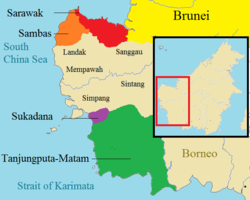Our website is made possible by displaying online advertisements to our visitors.
Please consider supporting us by disabling your ad blocker.
Sultanate of Sarawak
Sultanate of Sarawak | |||||||||
|---|---|---|---|---|---|---|---|---|---|
| 1599–1641 | |||||||||
|
Flag | |||||||||
 The polity of western Borneo, 17th century, with Sarawak in Red. The kingdoms that established close relationship with Sarawak are illustrated in colour, while other neighbouring kingdoms are represented in light brown. | |||||||||
| Capital | Santubong | ||||||||
| Common languages | Classical Malay | ||||||||
| Religion | Islam, local animism | ||||||||
| Government | Monarchy | ||||||||
| Sultan | |||||||||
• 1599–1641 | Sultan Ibrahim Ali Omar Shah | ||||||||
| History | |||||||||
• The foundation of Sarawak | 1599 | ||||||||
• Assassination of Sultan Tengah | 1641 | ||||||||
| |||||||||
| Today part of | Malaysia Indonesia | ||||||||
| History of Malaysia |
|---|
 |
|
|
| This article is part of a series on the |
| History of Brunei |
|---|
The Sultanate of Sarawak (Malay: كسلطانن ملايو سراوق دارالهنا, romanized: Kesultanan Sarawak) was a Malay kingdom, located in present-day Kuching Division, Sarawak. The kingdom was founded in 1599,[1] after the conquest of the preceding Santubong Kingdom and the later Sultanate of Brunei.[2]
The kingdom saw the reign of a sole sultan, Sultan Tengah, Prince of Brunei, known as Ibrahim Ali Omar Shah Ibni Sultan Muhammad Hassan of Sarawak.[3] The state established a close relationship with Brunei and Johor. It forged dynastic rules with the surrounding Malay kingdoms in western Borneo including the sultanates of Sambas, Sukadana and Tanjungpura-Matan.[4]
The sultanate was dissolved following Sultan Tengah's assassination in 1641, after 42 years of rule.[5] The administration of the territory was then replaced by the local Malay governors appointed from Brunei, reunifying the area into the Bruneian empire.
The historical significance of the Sarawak Sultanate, alongside neighboring Malay kingdoms such as Santubong (near Kuching), Sadong (near Samarahan), Saribas, Kalaka (both in Betong Division), Lingga and Banting (both in Sri Aman) collectively shaped the pre-Brooke Sarawakian history.[6][7]
- ^ Larsen 2012
- ^ Sahari, Suriani; McLaughlin, Tom. "History of the people from the Sarawak River Valley".
- ^ Porritt 2012
- ^ Bruneidesi 2017
- ^ Cite error: The named reference
Ritchie 2023was invoked but never defined (see the help page). - ^ Said, Sanib (2012). "Sejarah Awal Kepulauan Melayu: Lima Buah Negeri Warisan Sarawak yang Hilang (The Heritage if the Early History of Sarawak: The Five Lost Kingdom)" (PDF). Current Research in Malaysia. 1 (1): 21–50. Retrieved 19 December 2023.
- ^ [Sejarah kewujudan pentadbiran dua kerajaan dikaji https://www.utusanborneo.com.my/2016/01/16/sejarah-kewujudan-pentadbiran-dua-kerajaan-dikaji]
Previous Page Next Page



